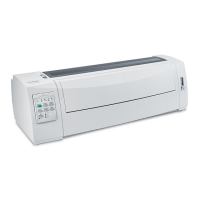Diagnostic aids 3-1
2580+, 2581+, 2590+, 2591+
3. Diagnostic aids
This chapter explains the tests and procedures to identify printer failures and verify if repairs have corrected the
problem. The printer does not need to be connected to a computer or terminal to run these tests.
The tests include the following:
• Power-on self test (POST)
• Print test
• Hex Trace mode (a computer or terminal is necessary)
The following are special machine modes that run when the printer is turned off and then back on:
Power-On Self Test (POST)
The following tests are automatically performed when the printer is turned on.
• LEDs Test—Checks operation of LEDs on the operator panel. The LEDs turn on and off after
the printer is turned on, and then all LEDs turn on for a few seconds.
• RAM Test—Checks that the CPU can write/read the RAM.
• Font ROM/Microcode Sum Test—Checks that the ROM data is correct.
• Timer/Interrupt Controller Test—Checks that this function works.
• NVRAM Test—Checks that the NVRAM data is correct.
• Switch Scan Test—Checks the buttons on operator panel.
• Carrier Initialization—Carrier moves to the left to activate the Home Position sensor, and then
moves to the first print position.
• Feed Initialization—Form feed motor rotates forward and then backward.
If any errors occur during the POST tests, a combination of blinking LEDs indicates which test failed. See
“Start” on page 2-1.
Turn printer on while pressing Result
LineFeed Prints print test with sample fonts.
Tractor Sets printer in Hex Trace mode.
Load/Unload and Tractor Disables/enables Operator Panel
Lockout mode.
Tearoff and Tractor with the
printhead at the left limit
Resets the printer to the World Trade
defaults.
Tearoff and Load/Unload with the
printhead at the left limit
Resets the printer to the U. S. defaults.

